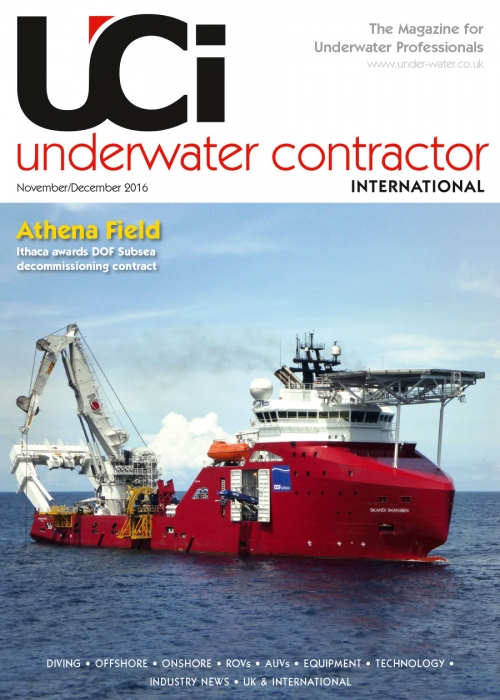
The Magazine for Underwater Professionals
![]() Nov/Dec 2015
Nov/Dec 2015
INDUSTRY NEWS - EQUIPMENT & TECHNOLOGY
New emergency disconnection tool from Allspeeds
Allspeeds, UK, reports the development of an emergency disconnection tool (EDT) for subsea intervention systems. The Webtool EDT enables rapid cutting of umbilical multiple fluid transfer jumpers, electrical lines and tension wire in the event the DP surface vessel drifts off-station.
“As an integral part of either a workover tool or dedicated emergency disconnect package, the Webtool EDT guillotine cutter is a simpler and quicker emergency disconnection than more complex multi-line stabplate systems,” said Allspeeds. “It offers considerable weight savings compared with other emergency disconnect systems, and is easily retrofitted to intervention systems.”
Within a well intervention emergency disconnect package, the umbilical is connected to a sacrificial hose and cable bundle, and securely positioned in the mouth of the Webtool EDT emergency cutter, the Lancashire-based company added. This ensures the umbilical is severed in the correct place, within seconds, it said.
The hydraulically-operated Webtool EDT is able to cut up to 30 bundled 10,000psi rated hydraulic jumpers and electrical lines in an emergency disconnect situation, at water depths up to 3000 metres. Once activated the umbilical is cut in a single operation.
Designed for deployment for extended periods subsea, Webtool EDT can be function tested in situ, ensuring the tool is ready for use in the event of an emergency.
Norway-headquartered Imenco reports it is “changing the game of subsea video”.
“For the first time, live subsea video can be digitally transmitted via Ethernet without significant latency,” the company said.
The firm’s new SubVIS platform is based on embedding a computer into the camera, making it ready for advanced image enhancement and computer vision.
“We have effectively made a dedicated computer especially designed for low latency video processing, based on smart phone technology,” said Imenco. “Full digital video transmission opens up an array of applications in the control room.”
Similar to the smart phone technology, Imenco said an important part of its philosophy is to ensure an open architecture to allow third parties to fully integrate these cameras into their control systems and to write software applications to increase the popularity and usefulness of the platform. This will allow users the freedom to tailor the package to suit their own specific demands, as well as integrating own video analysis function algorithms and image enhancement on top of the core software, the company said, adding that the system opens up the use of image metadata, which represents great advantages.
“One of the most innovative and exciting features that will be developed on this system is that subsea devices can be made to automatically communicate with each other. This allows, for example, the camera to tell the lights to reduce intensity and deliver optimum level of light,” Imenco said.
Aberdeen, UK-based engineering firm OceanTools reports the release of C-Scan, its new laser-based optical 3D scanning system.
“At OceanTools we believe that many of the challenges faced by today’s energy producers can be met successfully by the targeted application of innovative technologies designed to help achieve greater control of key production costs,” explained Kevin Parker, OceanTools managing director. “As an industry partner, OceanTools believes in actively engaging its own substantial in-house engineering expertise to develop simple, robust and cost effective technical solutions to identified industry obstacles and bottlenecks. C-Scan is OceanTools’ latest technical offering in support of those beliefs.”
Encased within subsea housings providing an operational depth rated at 3000 metres, the C-Scan system comprises a high-precision, 360-degree rotary encoder plus a laser triangulation system capable of taking measurements 15 times per second and generating 700 discrete data points per scan.
With a range of up to five metres and a resolution down to 0.5 millimetres, measurements are accurately detected, analysed and processed by specially developed software, enabling the user to both visualise the target object and to take accurate measurements of specific suspect anomalies within moments of the scan taking place, Parker said.
Data generated by the system may also be exported to an external CAD package where supplementary tools such as the colour contouring of heights/distances may be rendered for additional analysis and reporting.
Deep Trekker, Canada, reports the release of a new military underwater diveable control system for its remotely operate vehicles. The controller is depth rated to 75 metres and can be equipped with up to 150 metres of tether.
“This advancement in underwater technology will increase the safety of military and stealth dive missions as well as give divers the ability to investigate areas too dangerous or remote for them to access,” said Deep Trekker. “The underwater control system provides the same easy to use controls for the Deep Trekker ROVs, while providing an integrated super-bright screen for viewing what the ROV camera sees, all while underwater.
“Never before has there been a remote surveillance tool that can be controlled and operated while completing a dive. Surveillance missions or unknown territories can first be investigated by the Deep Trekker remotely operated vehicle while the diver remains a safe distance away.”


